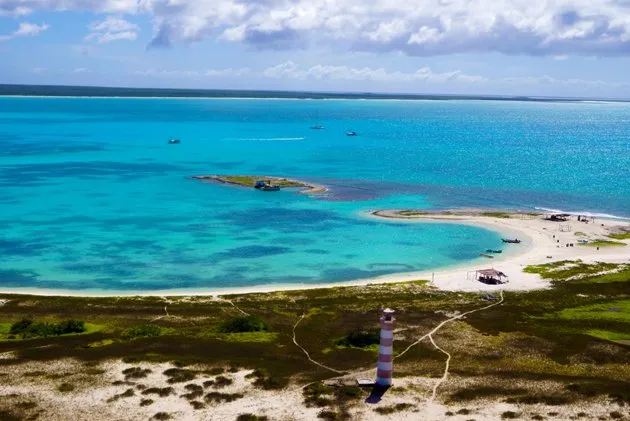
Wonderful natural scenes appear in the Caribbean Sea. Its coasts full of magic, where the colonizers thought to arrive at Eden, make historians agree that the Christopher Columbus expedition described the Venezuelan lands as "El Paraíso". Do not you think it's a great destination for this Christmas?
But this is just one of the stories that lie in coastal lands, because Alonso de Ojeda, a crew member of the ships of Christopher Columbus and then captain of his own expedition along the Venezuelan coast, knows love in an indigenous tribe that He lived in Coquivacoa, a history of delivery immersed in the first documented crossbreeding in history.
Impressive stories about the Gulf of Paria, the cays of the Morrocoy National Park, Golfo Triste, Chichiriviche, among others, explain the natural beauty of these beaches that receive the waves of the Caribbean Sea.
On May 18, 1499 begins the expedition of Alonso de Ojeda to the "New World", a predominant noun in the projects submitted to the Spanish crown for travel to the Caribbean seas.
It was then that this character, along with Juan de la Cosa and Américo Vespucio, made the first tour of Venezuelan coasts, in addition to being the first Spaniards to set foot on the island of Margarita and the eastern coast of Mochima, discover La Tortuga Island and make the first map of Venezuela.
It is incredible the amount of stories that can be unearthed in the sands of Venezuelan beaches, and many of them lie on La Tortuga Island
It is incredible the amount of stories that can be unearthed in the sands of Venezuelan beaches, and many of them rest on La Tortuga Island, the second largest in Venezuela and the last one left in the Caribbean Sea with indications of latent virginity due to the lack of actions of the human hand, covered by white sand that stands out before the diverse range of blue tones that project its crystalline waters.
According to one of the oldest mentions of the island presented in the text "Geographic Relation of Our Lady of Caraballeda and Santiago de León, of 1578", on the island salt was extracted, one of the first trades that was established in this territory by Dutch, who in 1605 were expelled by the Spaniards from the Araya salt mines, staying there until 1631, the year in which the first battle waged on the high seas for salt was unleashed.
When visiting this prestigious island, it seems incredible that there the Dutch had formed a point of salt production, because according to an old map that is in the Museum of the Indian, in Spain, these natives of Holland had a fort built with bricks. The salt pans were in the eastern part of the island and a port of embarkation on the south coast where they built a dock to load the salt.
A good indication of this story, are the wild goats that run freely on the island.
In 1871 it is part of the so-called Archipelago de Colon, consisting of the islands of Venezuela including the archipelago of Los Roques, and it was not until 1938 when La Tortuga Island was integrated into the Federal Dependencies.
The Turtle is born with the earth

In 1974 it was called Zone of Tourist Interest under decree number 1625, and it is in 2005, under the mandate of the Supreme Commander, Hugo Chávez Frías, when the Plan for the Regulation, Regulation and Use of the Areas of Public Utility and Interest is issued. Tourism for the Federal Dependencies: La Tortuga Island, Las Tortuguillas, Cayo Herradura and Los Palanquines, published in Gazette number 38,179, under decree number 3,448.
The story changes but this beautiful island continues in the Caribbean beating and living every decade, centennial and millennium against the beautiful Venezuelan coasts that ask to be rescued from the chronic destruction in which they have been intruded since the arrival of the European invasion.
Our island is natural heritage

Today the efforts of the Bolivarian Government to recover and preserve the natural fields of the Venezuelan coasts, are materializing with the voluntary contribution of the people, an initiative that has been extended to the islands and archipelagos that are in a delicate situation due to the so-called global warming and environmental pollution.
The privilege of having a dedicated, hardworking, contributing and volunteer people opens the way to the strategies implemented by the State in which social participation and environmental preservation lead to the possibility of sustainable tourism, and generate the implementation of an alternative policy to capitalism such as Ecosocialism.
For this, Venezuela continues to write history in stone, with the recovery through days of cleaning the blue beaches for life, to continue enjoying everything that nature gives us.
The Turtle is not far from being affected by human action, for years it has been a victim of irresponsible tourism.
La Tortuga is not far from being affected by human action, because for years this island has been a victim of irresponsible tourism, as boats such as yachts and sports boats, threw solid waste on the island, generating a large accumulation of garbage.
In addition, the boats that arrived at the island, anchored very close to the beaches, generating the removal of the marine floor, and in turn contamination and deterioration of the ecosystem.
Also, the irresponsibility of inhabitants of lands near La Tortuga, when throwing garbage into the sea, indirectly contributed to their contamination, since the action of the tide and the marine currents, move the solid waste to its banks.
Just as our ancestors took care of these coasts of the Spanish invasion, as in Chichiriviche, when the natives received with a rain of arrows the expedition of Alonso de Ojeda, protecting their space; Venezuelans have the peaceful tools to continue protecting these beauties through the Law, the contribution, the union and the will to make our coasts increasingly "More Chéveres".